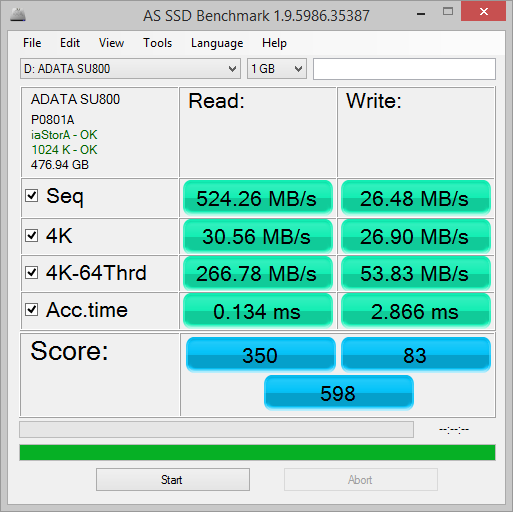TRIM Performance:
While SSD's offer many benefits, there are some downsides to using flash memory. One of the biggest issues people run into is performance degradation. Over time, an SSD will run out of fresh blocks and will have to write over data the file system has marked as deleted. This procedure is very complicated and can slow an SSD's write speeds considerably.
To fix this problem, most manufacturers have added TRIM support to their SSDs. The TRIM command allows an operating system, such as Windows 7, to tell an SSD which data blocks are no longer in use. Using this information, the drive pro-actively erases these blocks and adds them to the free block pool.

To test the SU800's TRIM and garbage collection functions, I first put the drive in a "dirty" state. I used Iometer to fill 80% of the drive and then ran a random write test for 30 minutes. This had little impact on the SU800's read speed. However, its average writing speed dropped to a mere 26.48 MB/s.

ADATA Ultimate SU800 - Dirty
To see how well the SU800 could recover, I let the computer sit for about 30 minutes and then reran the test. The drive wasn't able to reach the factory fresh performance shown in our earlier tests. However, its average write speed climbed up to 231.00 MB/s.

ADATA Ultimate SU800 - After TRIM
Lastly, I used Parted Magic to perform a secure erase on the SU800. With the drive wiped clean, it had average read and write speeds of 529.42 MB/s and 481.56 MB/s, respectively.

ADATA Ultimate SU800 - Secure Erased
Final Thoughts:
While not the fastest or most feature packed SSD to come through the 'Labs, the ADATA Ultimate SU800 delivers a lot of bang for your buck. The drive combines Silicon Motion's SM2258 controller with Micron's 3D TLC NAND to deliver good performance and a high level of endurance at a price that won't break the bank. In our sequential read and write tests, the 512GB version of the drive was able to read at speeds as high as 563 MB/s and write at speeds in excess of 516 MB/s. It also did surprisingly well in our random write tests, producing more than 74,000 IOPS at low queue depths.
Of course, fast read and write speeds aren't the only things the Ulimate SU800 has to offer. Like most TLC-based SSDs, the drive uses an SLC caching algorithm to optimize performance during sustained writes. ADATA doesn't say how big the cache is, but we were able to write anywhere from 90 to 160GB worth of data before it filled and performance dropped to non-accelerated levels. The SU800 also supports DEVSLP (Device Sleep) technology for longer battery life and includes features like LDPC error correction, Data Shaping, and a RAID Engine to ensure data integrity and provide greater durability.
The Ultimate SU800 is available now in 128GB, 256GB, 512GB and 1TB capacities. Prices on Amazon.com currently range from $50 up to $290, with the 512GB version reviewed here retailing for about $130.

Highs:
- Available in 128GB, 256GB, 512GB and 1TB capacities
- Silicon Motion SM2258 controller
- Micron 3D TLC NAND
- Good sequential and random read and write performance
- Huge SLC cache
- RAID Engine, Data Shaping and LDPC ECC technologies
- Ultra-slim form factor
- Includes mounting spacer for 9.5mm applications
- DEVSLP power mode
- SSD Toolbox and Migration Utility
- Reasonably priced
- 3 year warranty
Lows:
- Write speed drops considerably when SLC cache is full
- Does not support hardware based encryption

